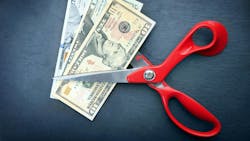Editor’s note: We broke this article into two parts. In the September issue, we dove into wages, benefits, facilities, and maintenance expenses.
Having run hundreds of performance groups over the past 40 years, FenderBender challenged me to recap the key learnings on the main topics the groups discuss. This is the part two of the final installment of the financial series and concerns limiting overhead expenses and optimizing operating profit.
Marketing Expense
These expenses typically run 1.0% to 2.1%, but in this case, the more profitable shops invested nearer to 2% where less profitable shops only invested 1% on marketing. Let’s look at some of the largest investment:
Insurance Discounts: Some repairers prefer to have these costs included as part of the cost of goods sold, and that is OK. The key here is to evaluate the sales source report and profitability per account and then push or back off the less profitable companies and reduce the less profitable company’s discount fees.
Rental Vehicle Expenses: Again, having a quality-oriented repair culture, will save money in less rework cost, but it also pays of in reduced company paid rentals. Loaner vehicles come with a bit of liability, but if used to capture work to optimize flow, they can boost overall profitability.
Website: This is your 24-hour customer lobby where people can get to know your company’s capabilities, have tips on what to consider after an accident, to schedule a repair, and even apply for a job. Keep the site current but evaluate site hosting and other fees periodically.
Social Media: If you're providing “legendary service” to your customer and you ask, your customers will post positive reviews on Google and other sites but manage this closely. Seek to repair negative reviews or at least to solicit more positives to dilute the negative.
CRM: The positive customer experiences are the positive “gold” a shop can mine. They can use Customer Relationship Management systems like BodyShop Booster or Phoenix Solutions to target past customers or prospective customer mailing/contact lists to stimulate traffic from past customers or their friends and family.
Local Team Sponsorships: As you consider these investments, if you’re going to optimize the return, plan to attend the end of season banquet or some of the events so they realize you care about them and their community, otherwise, don’t invest in these things.
Print / Banner Expenses: If you have partners, work with them to get permission to install posters, banners and brochures to allow customers to become aware of your capabilities while they wait for an oil change or even when they come to your repair center.
Billboard or other media: If you’re going to do this, plan on a clever scheme or gimmick to make people remember the shop in a positive way.
You may note that OEM certifications aren’t listed here, based on their limited return, we consider the OEM certification costs an educational investment.
Professional Expenses
These expenses typically run 1.5% to 1.7%, and here are some of the largest expenditures and how you can control them:
- Accounting: You can reduce bookkeeping fees by having the parts coordinator effectively post invoices accurately, the CSR enter the paint & material, sublet and overhead expense invoices as they come in and close files within 24 hours of delivery, have the PM submit payroll information accurately and then have the payroll service provide a journal entry for accounting. GM and PM need to manage the month-end WIP and the supplier returns the P & M and non-paint invoice to minimum. Instead, have the accountant be focused on tax planning to minimize overall enterprise tax liability.
- Clubs: Evaluate whether your attending group functions and if membership adds value to you or the organization?
- Consultancy: Well invested consultancy can be effective, but if the shop doesn’t follow-up and follow-through you may want to reconsider those expenses.
- Legal - AR: Limit Accounts Receivable by only releasing vehicles when you are paid in full, ensure your AR documentation is bullet proof with smaller, lesser known payers if you release them without approval
- Legal - HR: Hire judiciously, train and support vigerously, and avoid the fix vehicles right so customers have no need to sue you
- Business Clubs: Provide great business-to-business selling opportunities
IT Expense
These expenses typically run .6% to 1.4%, and here are some of the largest expenditures and how you can control them:
- Estimating Systems: Is more than one software package necessary to serve the payers (DRP’s) we value. If you have more than one, who maintains the operation codes rates and times?
- Mechanical databases: If you maintain more than one, is it worthwhile and does someone know how to use effectively enough to make it worth the investment
- Management Systems: Evaluate number of users and user rights for all seats you are paying for. Are you using all the features of the system you are paying for, is someone investing the time to access reports and reviewing with the staff to optimize performance? If you have switched over the past 7 years, are you using the past database to market to past customers or acknowledge incoming customers as repeat and then treat them as a VIP client
- Office software: Evaluate number of users and subscriptions to MS Office Suite and investigate all software packages and subscriptions you are subscribed to
Utilities Expense
These expenses typically run 1.0% to 1.1%, and here are some of the largest expenditures and how you can control them:
- Natural Gas: Ensure you have at least 12 paint labor hours worth of paint work in each booth cycle by putting loose parts in with other vehicles. Put a set-back thermostat on all radiant heaters, while remembering to remove snow from vehicles prior to moving them into the shop to avoid having to heat the object enough to melt and evaporate that moisture.
- Electricity: Stage electrical turn-ons in the morning. On office AC, put a setback thermostat on the HVAC system and put motion lights on bathrooms, closets and offices. Turn off exterior lit signs from 11 p.m. to 4:30 a.m. to avoid wasted electricity.
- Phone: Evaluate the phone plans, frequency of upgrades, and team / family members that should be on the shop phone account.
- Garbage: Invest in trash compactor and cardboard baler to reduce the amount of dumpsters necessary, and invest in storage racks to make it easy to sort and recyclable items up
Educational Expense
These expenses typically run .5% to 1.1%, but in this case, the more profitable shops invested 1.1% where less profitable shops only invested .5% on education. Let’s look at some of the largest investment:
Wages for New Hire or Technicians in Training: Removing these expenses from the cost of goods sold allows you to truly evaluate the costs relative to the sales. Moving technicians through their development path will help curb this cost long term.
Education or Training Costs: These investments are also generally well spent if you are improving their skills or removing administrative barriers to level flow. Seek out these training opportunities and then hold them accountable to implement their learnings upon their return.
OEM Certification Expenses: Evaluate the ROI for investing in OEM certifications by learning how their OEM repair procedures are organized and get their staff to invest time attending OEM training and listening to online OEM training snippets.
Performance Groups: These groups give you access to industry benchmarks and the ability to ask questions of peers who have implemented processes which will lead to their success. Some shops treat these expenses as a professional expense.
Other Expense
These expenses typically run .3% to .7%, and here are some of the largest expenditures and how you can control them:
- Bank Fees: Negotiate free checking if you maintain a minimum balance
- Office Supplies: Go paperless and limit paper to customer facing forms, and printed work orders for the staff. Minimize photocopying and instead scan things into the RO file of the management system.
- Credit Card Fees: Take down signs advertising the fact that you take credit cards. Post signs that if they choose to use a credit card, that a 3% fee will be added the balance being charged.
- Write-offs: Limiting AR at delivery, encouraging EFT and TeleChecks on customer paid checks can limit this. Document each AR call or communication and justify everything you ask for. If you do write off a sale, record it as an other, instead deduct the sales per the original RO classification to avoid paying sales tax on a sale that did not occur.
Conclusion
Overhead budgeting and expense review can be boring and challenging, but every dollar you save here adds a dollar to the bottom line. Ask your accountant for a General Journal report and review each expense to see if you need to continue it going forward. Set a goal of a certain dollar amount or percentage of sales. Your efforts here can directly impact your cash flow and ability to invest in passive income for your future!
About the Author
Steve Trapp
Steve Trapp is an internationally known consultant and speaker. His family operates a collision repair center in Wisconsin. He earned a degree in economics education and a minor in accounting from the University of Wisconsin.
After college, he worked for 3M in sales and marketing roles with the innovative 3M ARM$ training and software sales. He worked as a consultant for AutocheX doing financial consulting for a few years before joining AkzoNobel, where he started the industry’s first value-added program. While there, he started the industry’s first paint company-sponsored 20 groups and wrote numerous training programs with third-party experts on finance, marketing, selling, leadership, and other topics.
He later joined DuPont/Axalta, where he worked with Mike Anderson to manage their 20 groups and industry seminars. While at Axalta, he managed the North American Strategic Accounts SAM team and later the entire EMEA Strategic Accounts team. He followed that as senior consultant for LEAP, a global consulting firm that has presented in 10 countries and now again works for a major paint company.

